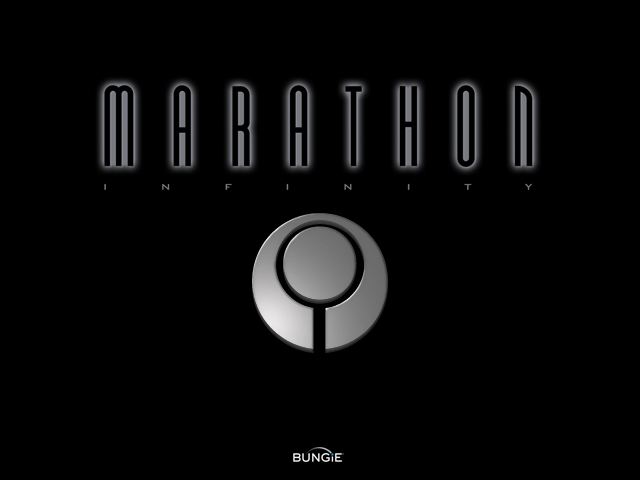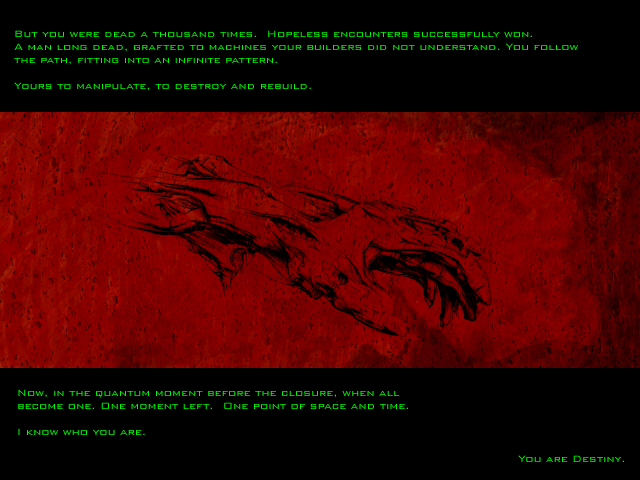Overview
 Marathon Infinity Title Screen
Marathon Infinity Title ScreenReleased on October 15, 1996, Marathon Infinity is the third and final title in the Marathon Trilogy of science-fiction first-person shooters produced and developed by Bungie Software. It features a new single-player campaign which concludes the story of the security officer at the center of both Marathon and Marathon 2: Durandal, three exceedingly challenging "Vidmaster" maps, and also 23 netmaps to bolster's Marathon's multiplayer mode. Perhaps most prominently, the game shipped with Forge, a Marathon map editor, and Anvil, a utility for editing weapons, enemies, textures, sounds, and the like. Marathon Infinity was so named because of these tools, as they were intended to extend the life of the game indefinitely by giving fans access to essentially the same tools Bungie used to make their maps. The importance of Forge and Anvil in this release can be seen in the game's manual, which devotes over half of its length to explaining the proper use of these utilities.
Unlike the previous game, Marathon Infinity was never officially ported to the PC, and like the original game it is only legally playable on modern systems due to the 1999 release of the Marathon 2 source code, which led to the development of the cross-platform Aleph One project, and the official freeware release of the Trilogy in 2005, which allows all three games in the series to be freely downloaded. More recently, as part of Bungie's 20th Anniversary celebration in 2011, the source code to Marathon Infinity was officially made public.
Plot
The story of Marathon Infinity represents a fairly dramatic structural departure from the more traditional narratives of its forebears. As Greg Kirkpatrick, the principal writer on all three Marathon games, explains it, Infinity's story was intended to be an "experiment" in discovering "how much people could digest from a complex, hard to follow story." The nature of many of the game's events as well as their meaning in the context of the story are not explicitly made clear to the player, who is expected to instead piece them together based on terminal messages and prior knowledge of the series, and as a result the specifics of what is taking place during the game's scenario, entitled "Blood Tides of Lh'owon", was and continues to be a source of some debate among the Marathon fan community. One of the few undisputed facts is that the player character's primary motivation is to stop an eldritch being named the W'rkncacnter, which was released from its imprisonment in Lh'owon's sun at the end of Marathon 2. This beast of chaos, if left unchecked, would spell the death of the known universe.
 Infinity's storyline waxes far more metaphysical than its predecessors.
Infinity's storyline waxes far more metaphysical than its predecessors.One of the more widely held interpretations of Infinity's storyline is that the security officer is being transported by ancient Jjaro technology into alternate timelines (other interpretations postulate that it is the W'rkncacnter's influence that is transporting him, or that he is merely dreaming), wherein he must find a means to prevent the W'rkncacnter from being unleashed. Of the more confusing aspects from an interpretive standpoint is that it is never specifically stated that the player is traveling through time, space, or the mind, and furthermore within these timelines no one appears to be aware of the fact that the player character is experiencing this phenomenon. These excursions are set for the most part contemporaneous to the second game's storyline as the player (presumably) tries to correct the course of events which led to the Pfhor's launching of the trih xeem device, which precipitated the release of the W'rkncacnter. In some scenarios, the security officer will experience wildly different realities in which he fights alongside Tycho and the Pfhor, while in others he aids Durandal and his men as he did in the previous game.
Intermittently the player is transported to surreal transitional levels which seem to signal the end of one timeline and the beginning of another, and in addition it is possible for the player to prematurely access versions of the game's final level before they have the means to truly complete it, driving home that the purpose of these jumps is to create a favorable outcome which allows him to subdue the W'rkncacnter. Eventually, the player will find their way to the final level, an ancient Jjaro station which presents the key to containing the W'rkncacnter. The security officer is seemingly successful in his efforts, however the game's epilogue leaves the full impact of the game's proceedings open to interpretation.
Gameplay
See also: Marathon 2
 Extremely tough grey Pfhor materialize later in the game.
Extremely tough grey Pfhor materialize later in the game.Gameplay is mostly unchanged between Marathon 2 and Marathon Infinity. Most levels require the player to traverse a large expanse in order to complete a certian objective or objectives, after which point the player can be teleported to the next stage by way of a computer terminal within the environment. As a consequence of the player's frequent shifting between realities, many maps will feature the Pfhor as allies and Durandal's human forces as enemies, and exactly what constitutes friend or foe changes a number of times over the course of the game. The campaign also features a number of story-relevant secret levels as well as two additional "coop carnage break" levels intended for those playing through the game cooperatively. The aforementioned secret levels can be accessed from one of three near-identical "Electric Sheep" levels interspersed throughout the campaign, and from here players can also skip or replay large swaths of the game if they so choose, reinforcing the notion that the game's story does not unfold in a strictly chronological fashion. Also of note is the fact that Infinity features the return of vacuum levels in which the player's oxygen supply is slowly diminishing, which was a mechanic entirely absent in the second game.
Weapons
All of Marathon 2's weapons return in Infinity, accompanied by a single new addition: the KKV-7 10mm SMG Flechette. As before, the protagonist's ability to use individual weapons is limited not only by their access to them but also the player's current circumstances. Almost all weapons are completely useless while submerged, for instance, and certain armaments, such as the Assault Rifle and the SPNKR-XP, are simply not suitable for use in depressurized atmospheres.
| Appearance | Pickup Icon | Description |
|---|
 KKV-7 10mm SMG Flechette KKV-7 10mm SMG Flechette |  SMG Flechette Pickup SMG Flechette Pickup | KKV-7 10mm SMG FlechetteAs Marthon Infinity's only new weapon, the KKV-7 is an extremely versatile armament that can be used in almost any situation. It is the only firearm in the game which can be discharged underwater without causing harm to the player, and it can furthermore be used safely in a vacuum. Due to its longer and more pointed gun barrel, it is also much more accurate than the standard Assault Rifle. Like most ballistic weapons in Marathon, though, it is not very effective against armored targets, and it suffers somewhat from a fairly small magazine and a general paucity of ammo in most levels. |
Enemies
The player will encounter primarily the same enemies in Infinity that were on display in Marathon 2. Due to the nature of the single-player game, many enemies will show up as allied units during specific missions, and furthermore unit types that were previously only allies, such as Bobs and S'pht'Kr, may appear to be hostile depending on the scenario. Introduced in Marathon Infinity are several grey "super" versions of standard Marathon enemies, which are far tougher, deadlier, and faster than their normal counterparts, although these mostly factor into the game's penultimate level, "You Think You're Big Time? You're Gonna Die Big Time!" In terms of entirely new enemy types, the only unit fitting of the description is a new vacuum-suited human opponent called the "Vacuum Bob."
| Appearance | Description |
|---|
 Vacuum Bob Vacuum Bob | Vacuum BobIntroduced about midway through the game, Vacuum Bobs are so named due the vacuum-sealed armor suits that they wear. They are significantly more hardy than the average Bob, and are also outfitted standard with Zeus-Class Fusion Pistols, making them more dangerous opponents. Vacuum Bobs come in either blue or green varieties, with the latter of them being the tougher of the two. Much like Hunters, they will undergo a "violent" death if killed with certain weaponry, such as the Fusion Pistol. When this happens, the Bob in question will explode rather than simply crumpling to the floor, causing splash damage to any nearby targets. |
Log in to comment